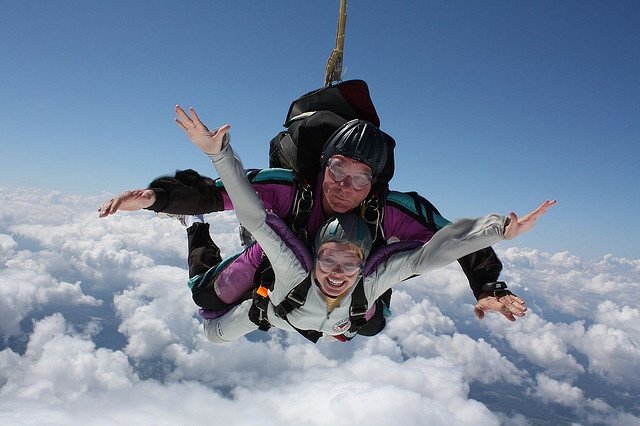The rush of jumping out of an airplane and free-falling before gliding back to earth with a parachute is a unique experience that is addictive. However, while skydiving can be an unforgettable and safe activity for adults, it’s essential to consider the significant safety measures involved, especially when contemplating if it’s suitable for children, let alone babies. Skydiving isn’t open to just anyone because there are stringent requirements, primarily around age and physical readiness.
For example, the legal minimum age in the United States is 18. At the same time, some places might allow minors to skydive with parental consent, but this typically applies to older teenagers, not infants or young children. Participants should be able to process instructions, remain calm under pressure, and physically handle the jump and landing. It is restricted from infants and children until they are up to the required age. We’ll delve into the requirements for skydiving, the specific safety concerns for infants, and expert opinions about babies skydiving. Finally, we’ll suggest safer alternatives for families seeking adventure.
Safety Skydiving Concerns for Babies
The safety concerns are amplified because babies skydiving might sound far-fetched, but it’s important to understand why this activity is not practicable for infants. There are physical risks involved in this process, especially the impact of high altitudes and rapid descents on a baby’s body, and the potential for injury during the jump and landing.
Fragility of Baby’s Bodies
A baby’s immune and respiratory systems are not fully developed, so the stress and physical exertion of skydiving could easily overwhelm these systems, leading to serious health complications. The physical demands of skydiving can damage their fragile and sensitive bones, including the force of free fall and the impact of landing, which are too intense for their fragile systems to handle. Unlike adults, babies cannot brace themselves or adjust their bodies to mitigate these forces, making them highly susceptible to injury.
Changes in Pressure and Oxygen Levels
The air pressure at high altitudes is significantly lower than at ground level. Adults can generally adjust to these changes, but babies cannot. The rapid change in pressure during ascent and descent can cause severe discomfort and potentially harmful effects on a baby’s ears and sinuses. It can lead to barotrauma, an injury caused by a difference in pressure between the inside and outside of a body part, like the ear. Low oxygen levels can lead to hypoxia, a condition where the body doesn’t get enough oxygen, which is especially dangerous for infants.
Impact on Brain Development
Traumatic experiences can interfere with this process such that chronic stress and fear can alter the way a baby’s brain develops, particularly in areas related to emotion regulation and stress response. The amygdala, responsible for processing fear, can become overactive, while the hippocampus, involved in memory and learning, can be affected in ways that impair cognitive function.
Expert Opinions on Skydiving for Babies
Most skydiving centers have strict age limits, typically not allowing anyone under 18 to participate. This isn’t just a legal formality but a critical safety measure. Mark Thompson, a seasoned skydiving instructor, explains, “Skydiving requires a level of physical and mental readiness that young children simply don’t possess. Even with tandem jumps, where an experienced instructor is in control, the physical demands and potential risks are too great for minors, let alone babies.”
While some activities allow for parental consent for minors, skydiving is typically excluded from this due to its high-risk nature. Mitchell explains, “Even with parental consent, no reputable skydiving center would allow a baby to jump. The legal liabilities and ethical considerations are significant. Ensuring the safety of all participants is paramount, and in the case of babies, it’s clear that the risks far outweigh any possible benefits.”
Alternatives to Skydiving For Families
Kayaking and Canoeing
Water sports like kayaking and canoeing can be thrilling and fun, especially with siblings and loved ones. Many lakes and rivers offer calm waters perfect for beginners and young children, this is a great way to enjoy the outdoors as an alternative to skydiving.
Family Biking
Little children can enjoy the cool and fresh atmosphere while biking with their parents or siblings. Choose bike paths or trails that are safe and suitable for children as many parks and recreation areas offer designated biking trails perfect for family outings.
Camping
Setting up a tent, cooking over a campfire, and exploring the wilderness can be an exhilarating experience for kids. Many campgrounds offer family-friendly amenities and activities, making it a great way to spend quality time together.
Having analyzed why skydiving for babies is dangerous, it’s best to leave it to the grown-ups and look for safer ways to feed your family’s adventurous spirit. Prioritizing your child’s safety and well-being ensures they can enjoy many exciting adventures as they grow, building memories and skills that will last a lifetime.










I do believe all the ideas youve presented for your post They are really convincing and will certainly work Nonetheless the posts are too short for novices May just you please lengthen them a little from subsequent time Thanks for the post
We appreciate your response regarding the article, our team will work on that. Thank you.